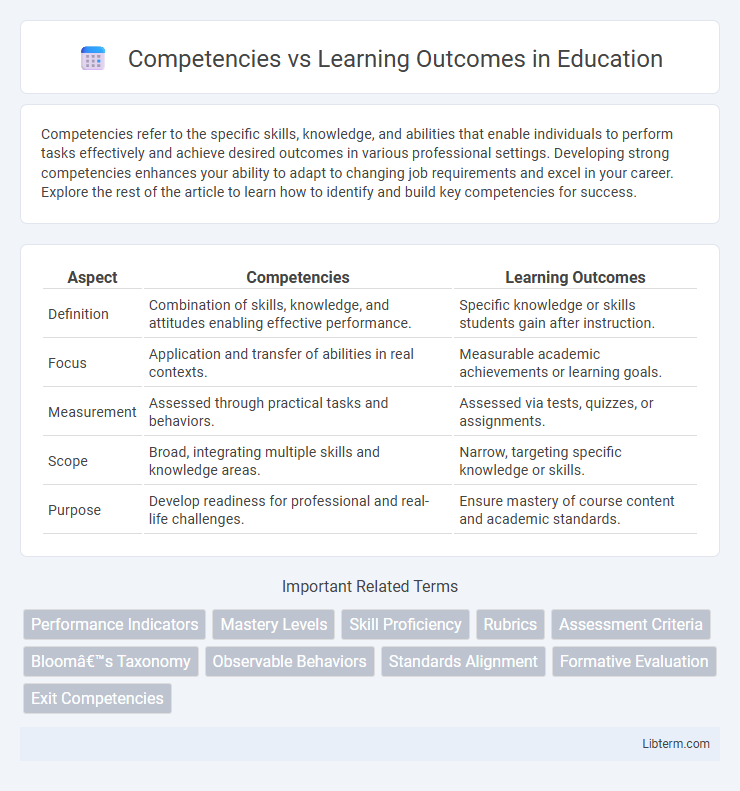Competencies refer to the specific skills, knowledge, and abilities that enable individuals to perform tasks effectively and achieve desired outcomes in various professional settings. Developing strong competencies enhances your ability to adapt to changing job requirements and excel in your career. Explore the rest of the article to learn how to identify and build key competencies for success.
Table of Comparison
| Aspect | Competencies | Learning Outcomes |
|---|---|---|
| Definition | Combination of skills, knowledge, and attitudes enabling effective performance. | Specific knowledge or skills students gain after instruction. |
| Focus | Application and transfer of abilities in real contexts. | Measurable academic achievements or learning goals. |
| Measurement | Assessed through practical tasks and behaviors. | Assessed via tests, quizzes, or assignments. |
| Scope | Broad, integrating multiple skills and knowledge areas. | Narrow, targeting specific knowledge or skills. |
| Purpose | Develop readiness for professional and real-life challenges. | Ensure mastery of course content and academic standards. |
Understanding Competencies: Definition and Importance
Competencies refer to a set of knowledge, skills, attitudes, and behaviors that enable individuals to perform tasks effectively and meet organizational or professional standards. Understanding competencies is crucial as they provide a clear framework for evaluating employee performance, guiding professional development, and aligning workforce capabilities with business goals. Defining competencies helps create targeted training programs, improve recruitment processes, and measure career progression accurately.
What Are Learning Outcomes? An Overview
Learning outcomes define specific skills, knowledge, and attitudes a learner is expected to acquire after completing a course or program. They provide measurable, clear criteria for assessing student performance and guide curriculum development to ensure alignment with educational goals. Unlike broad competencies, learning outcomes focus on concrete, achievable targets that facilitate effective teaching and evaluation.
Key Differences Between Competencies and Learning Outcomes
Competencies define the specific skills, knowledge, and behaviors required to perform a job or task effectively, emphasizing practical application and proficiency levels. Learning outcomes describe measurable statements that specify what learners are expected to know, understand, or be able to do after completing a course or program. The key difference lies in competencies focusing on real-world performance standards, while learning outcomes prioritize academic or training achievements.
The Role of Competencies in Education and Training
Competencies in education and training define the essential skills, knowledge, and attitudes required to perform tasks effectively, providing a clear framework for curriculum design and assessment. They ensure that learners acquire practical abilities aligned with real-world demands, facilitating workforce readiness and lifelong learning. Emphasizing competencies enhances personalized learning paths and improves the alignment between educational programs and industry standards.
How Learning Outcomes Shape Curriculum Design
Learning outcomes provide specific, measurable goals that guide curriculum design by clearly defining what students are expected to know and achieve upon completion of a course. This precise articulation of skills and knowledge ensures alignment between instructional activities, assessments, and desired competencies, facilitating targeted and effective teaching strategies. Curriculum designers use learning outcomes to create coherent modules that progressively build essential competencies, ensuring educational programs meet academic and professional standards.
Assessing Competencies vs Evaluating Learning Outcomes
Assessing competencies involves measuring a learner's ability to apply knowledge, skills, and attitudes in real-world scenarios, emphasizing practical performance and mastery. Evaluating learning outcomes focuses on determining the extent to which specific educational objectives or goals have been achieved, often through tests or assignments that reflect knowledge acquisition. Competency assessment prioritizes demonstrable behaviors and skills integration, while learning outcome evaluation centers on cognitive understanding and measurable academic achievements.
Aligning Competencies With Learning Outcomes for Effective Learning
Aligning competencies with learning outcomes ensures that educational objectives directly reflect the skills and knowledge students must acquire, fostering measurable and targeted learning experiences. This alignment promotes clarity in curriculum design, enabling educators to develop assessments that accurately evaluate learners' abilities against defined competencies. Effective integration of competencies and learning outcomes supports personalized instruction and continuous improvement in educational quality.
Real-World Examples: Competencies and Learning Outcomes in Practice
Competencies define the skills and abilities required to perform tasks effectively, such as a medical professional demonstrating diagnostic accuracy, while learning outcomes specify what learners should achieve, like accurately identifying symptoms by course end. In practice, a software developer's competency includes coding proficiency and problem-solving, whereas the corresponding learning outcome might be the ability to build a functional application from scratch. Educational institutions and employers align competencies with learning outcomes to ensure practical skill acquisition and measurable achievement in real-world scenarios.
Benefits of Clearly Defined Competencies and Learning Outcomes
Clearly defined competencies and learning outcomes provide measurable indicators for skill acquisition and knowledge mastery, enhancing curriculum design and assessment accuracy. They enable personalized learning paths and targeted feedback, improving learner engagement and performance. Organizations benefit from aligned workforce capabilities, fostering efficient talent development and strategic goal achievement.
Best Practices for Integrating Competencies and Learning Outcomes
Effective integration of competencies and learning outcomes involves aligning specific, measurable skills with clear educational objectives to enhance learner assessment and curriculum design. Best practices include developing competency frameworks that map directly to learning outcomes, enabling consistent evaluation of student performance and ensuring relevant skill acquisition. Utilizing ongoing feedback mechanisms and collaborative stakeholder input further refines alignment, promoting continuous improvement in educational quality and practical applicability.
Competencies Infographic

 libterm.com
libterm.com